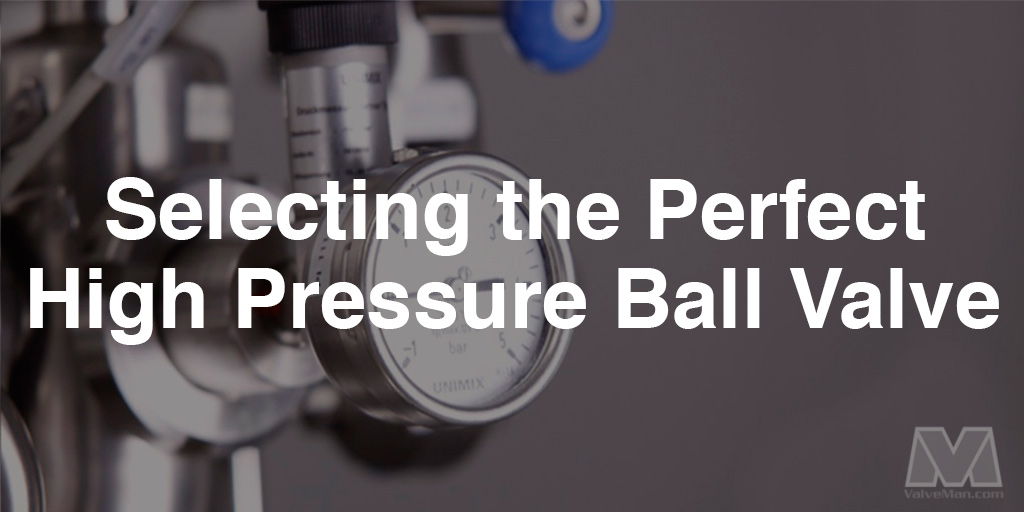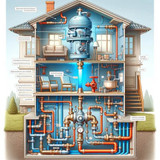High Pressure Ball Valves
Selecting the right high pressure ball valve for the job will involve a bit more consideration than choosing an ordinary, general service ball valve. For starters, you're working with higher pressures, which means higher stress on a valve housing's integrity. Many valves may be rated for high pressure, but not all valves are the same. Perfection is reflected in an attention to the details in manufacturing.
When selecting a high pressure ball valve, your main focus should be on quality of construction, particularly since ball valves regularly function as shut-off valves. Maintaining a seal at high pressure, for indefinite periods of time, in example, advocates the need for a superior level of materials and stress-handling capabilities. Superior performance from a high pressure ball valve, then, will be found in a part made with adherence to perfection.

What Is a High-Pressure Ball Valve?
A high-pressure ball valve is a ball valve specially designed to withstand high-pressure applications. Like other ball valves, it's a simple mechanism consisting of a ball with a bore drilled through the center.
How Does a High-Pressure Ball Valve Work?
As mentioned above, these valves consist of a ball with a bore drilled through it. By changing the alignment of the bore, the valve can be opened, closed, or throttled. However, like other high-pressure valves, they're capable of withstanding much more pressure than standard ball valves do.
Typically, these ball valves can be activated or deactivated using either a manual approach (much like any other faucet) or by incorporating an actuator, either electric or pneumatic.
What to Look For in a High Pressure Ball Valve
Obviously, you'll be looking for a valve that's rated for high pressure, but what does that mean in terms of construction and configuration? For starters, high pressure ball valves will be machined, rather than cast, from a single block of material. In this way, the valve housing retains an integrity--paramount for high pressure applications--a cast housing cannot match. A closer look at a product from DMIC will further illustrate what a perfect high pressure ball valve looks like.
What Are the Common Applications of High-Pressure Ball Valves?
High-pressure ball valves find uses in a wide array of applications, so we can't possibly list them all. Here are a few significant options:
- Oil and gas: High-pressure valves are often used in the oil and gas industries. Whether it's for the main gas pipelines or individual user systems, high-pressure valves are essential for regulating flow.
- Petrochemical: Chemical processing plants use high-pressure ball valves to maintain the correct flow and pressure within their systems.
- Power generation: When power plants are hydroelectric or steam-operated, they often use high-pressure ball valves to maintain a consistent rate of flow.
These are just a few of the many places where high-pressure valves and their sister products, the standard ball valves and electric ball valves, see regular use. Many other industries also rely on this type of mechanism to ensure safe and efficient flow through various parts of the system in question.
High-Pressure Ball Valves - Available Materials and Sizes
High-pressure ball valves are available in various materials because different uses and industries require different materials that react differently. For instance, in a hazardous material plant a stainless steel valve might be ideal since stainless steel is less corrosive. Some of the main materials high-pressure valves are made of are Carbon Steel and Stainless Steel.
Thanks to the wide array of industries they get used in, these valves also come in a range of sizes. Some of the most common sizes include the following:
- 1/4"
- 3/8"
- 1/2"
- 3/4"
- 1"
- 1-1/4"
- 1-1/2"
- 2"
- 2-1/2"
- 3"
- 4"
Of course, these aren't the only available options, but they are the most common materials and sizes.
What Are the Advantages of Using High-Pressure Ball Valves?
High-pressure valves come with an array of benefits and advantages, including the following:
- They can easily handle high-pressure applications, which helps to ensure reliable operation.
- The mechanism opens both quickly and easily when opening and closing, which serves to provide efficient flow control.
- High-pressure valves are durable and have a long service life, even when faced with harsh operating conditions.
- Thanks to the tight seal that the ball and seat design creates, this type of valve generally has minimal leakage.
Frequently Asked Questions (FAQs)
How Do High-Pressure Ball Valves Differ From Regular Ball Valves?
The main difference between high-pressure valves and standard ball valves is that high-pressure ball valves have a more robust construction to withstand the pressures associated with their purpose.
How Do I Select the Right High-Pressure Ball Valve for My Application?
When choosing the right high-pressure valve for your application, you need to bear in mind the pressure and temperature rating of your system as well as the type of materials being handled. You always want to ensure that the valves consist of something that won't react with the gas or liquid being handled.
Can High-Pressure Ball Valves Be Automated?
Yes, they can! Like most ball valves, you can readily add an electric actuator to these high-pressure valves to give you remote control over them (as with actuated ball valves).
How Should High-Pressure Ball Valves Be Maintained?
High-pressure valves should be checked and cleaned regularly to ensure that there's no buildup of corrosion or other debris within the system.
Where Can I Buy High-Pressure Ball Valves?
Here at ValveMan, we have an array of options to suit your every need. Whether you want stainless steel, or carbon-steel fittings, we have what you need. If you're struggling to find the right valve or need a quotation, feel free to contact us.
High Pressure Ball Valves - Related Articles
-320°F Cryogenic Liquid Nitrogen Valve - Buy Valves from ValveMan
Industrial Ball Valves - 9 Questions To Make The Right Choice
Everything you need to know about valve types
Using an Actuated Ball Valve Or a Solenoid Valve For Best Fluid Control In The System
How Does A Floating Piston Valve Work?
The Difference Between #150, #300, and #600 Pound Flanges
Choosing the Perfect Apollo 3 Way Valve
Why Choose a Bonomi Ball Valve?
Selecting the Best Apollo Ball Valve for Natural Gas Use
Difference Between a Vented Ball Valve and a Standard Ball Valve
Difference Between a 1, 2, and 3 Piece Valve
Product Profile: 3 Piece Firesafe High Performance Ball Valve
What is the Difference Between Full Port and Standard Porting?
Our Posts
View AllUnderstanding Valve Sizes and Measurement
Sizing the appropriate valve is critical to ensuring the performance of your system. Whether you'r …
Read MoreTypes of Water Valves
Hey there, fellow valve enthusiasts! We all know that valves play a crucial role in regulating th …
Read MoreWhat is a Backflow Preventer, and How Does it Work?
When a simple check valve is inadequate for the job, you need a backflow preventer. But knowing …
Read MoreValve inspection - main points of valve testing in Manufacture setting
Industrial facilities rely on different types of valves (such as check valves, for example) to con …
Read MoreTypes of Ball Valves
Ball valves are important components in a vast range of systems, from small family-owned workshops …
Read MoreUnderstanding valve standards and specifications
Hey there, fellow valve enthusiasts! Today, we're looking at valve codes, standards and specifica …
Read MoreHow to Tell if a Valve is On or Off
We have all been there before. You are staring at a valve; you know that you should know if it …
Read MoreUnderstanding Different Types of Valve Connections and Fittings
Hey there, fellow valve enthusiasts! We know valves play a crucial role in regulating the flow of li …
Read MoreTypes of Valve Handles: Lever and Handwheels
Whether you're involved in industrial work, plumbing, or you're a DIY enthusiast, you come across va …
Read MoreThe Basic Parts of a Valve
Valves quietly work in many different areas, even places you wouldn't expect. They're truly every …
Read MoreGas Ball Valves In Industrial Applications - 5 Things to Keep in Mind
Unlike the standard ball valves, most gas ball valves are tested and approved by CSA. These valves a …
Read MoreHow To Correctly Use A 3 Way Valve In Different Applications
To understand the "T"-port and an "L"-port 3-way valves and what makes them different, it's importan …
Read MoreIndustrial Ball Valves - 9 Questions To Make The Right Choice
Ball valves are versatile flow control devices suitable for extensive industrial applications. They …
Read MoreEverything you need to know about valve types
Valves play crucial roles in production lines and equipment performance across a multitude of ind …
Read MoreWhat is a Duty Cycle and How Does it Relate to Electric Ball Valves?
Electric actuation improves the efficiency of processes by maintaining the accuracy of the re …
Read MoreActuated Butterfly Valves 101: All You Need To Know About Their Application In Piping Systems
Butterfly valves are quarter-turn flow control or isolation devices, used for quick shut-off in p …
Read MorePractical Guide To Electric and Pneumatic Actuators – Which One To Choose?
While electrical and pneumatic actuators have several unique benefits and are preferred in differ …
Read MoreHow Do Check Valves Affect Water Pressure in the Piping System?
Check valves also known as "one-way" valves are autonomously operated unidirectional valves that all …
Read MoreUsing an Actuated Ball Valve Or a Solenoid Valve For Best Fluid Control In The System
Both ball valves and solenoid valves serve a wide variety of applications. From a&nb …
Read MoreWhat are the types of solenoid valves?
Favored for offering low power consumption, a compact space envelope, superior speed of ope …
Read More


















